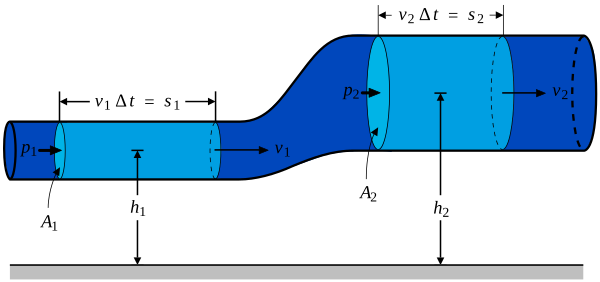I understand how to go about doing this problem if I'm using bernoulli's equation but what I don't understand is why do I have to use bernoulli's equation instead of P=F/A which would make the answer B. But the real answer is D because apparently I can't use P=F/A. Why is that? Thanks in advance!
You are using an out of date browser. It may not display this or other websites correctly.
You should upgrade or use an alternative browser.
You should upgrade or use an alternative browser.
ideal fluid flow
- Thread starter Halcyon32
- Start date
- Joined
- Sep 21, 2015
- Messages
- 252
- Reaction score
- 492
likely because force is mass dependent, and changing the volume changes the mass of fluid going through (aka p = m/v, if you double the radius then m = pv -> volume goes like radius cubed, so it would change the mass that way). My best guess 🙂
- Joined
- Dec 18, 2011
- Messages
- 1,689
- Reaction score
- 1,373
How would you get B if area is the denominator, which increased? You would be missing the height difference in Bernoulli's equation if you solve for P that way. That would be my guess. Either way, I'd expect pressure to drop if my r increased, so it already knocked out a,b, and c. You can't use P = F/A because that's for hydrostatic pressure.
Last edited:
Ah that's right it would be 1/4P not 4P. but in reference to the height difference, the question stem says its a horizontal pipe, meaning no height difference. But what you said about hydrostatic pressure cleared it up for me. Thank you!How would you get B if area is the denominator, which increased? You would be missing the height difference in Bernoulli's equation if you solve for P that way. That would be my guess. Either way, I'd expect pressure to drop if my r increased, so it already knocked out a,b, and c. You can't use P = F/A because that's for hydrostatic pressure.
- Joined
- Dec 18, 2011
- Messages
- 1,689
- Reaction score
- 1,373
I wouldn't assume no height difference because it says horizontal pipe. A lot of problems have horizontal pipes with differing heights. So unless it's stated, we don't know. It could be like for all we know, or the other way around where the bigger radius is closer to the ground instead of higher.


I just assumed that's what it meant b/c in the answer explanation when talking about using bernoulli's equation it only showed it as K=P+1/2(rho)(v)squared. but either way, the answer would still be D because even though the velocity decreases by a factor of 4 (from Q=Av) and thus decreases the "kinetic energy" portion of bernoulli's equation by a factor of 16 we don't know how much that would increase the pressure or even the "potential energy" portion of bernoulli's since they are not all proportional due to being added and not multiplied. That makes sense, right?I wouldn't assume no height difference because it says horizontal pipe. A lot of problems have horizontal pipes with differing heights. So unless it's stated, we don't know. It could be like for all we know, or the other way around where the bigger radius is closer to the ground instead of higher.

- Joined
- Dec 18, 2011
- Messages
- 1,689
- Reaction score
- 1,373
Yeah, I get what you're saying about the solution not being clear. The other part makes sense too. If you're doing ExamKrackers, they aren't good about explanation, but it's not bad for just discrete type questions. It's a good break from passages.
Haha yep its EK. I guess they have a reputation for this then because I'm dissatisfied with a lot of their explanations. Anyways thanks for your help 😀Yeah, I get what you're saying about the solution not being clear. The other part makes sense too. If you're doing ExamKrackers, they aren't good about explanation, but it's not bad for just discrete type questions. It's a good break from passages.
Wouldn't you use Poiseuille's principle since it's an ideal fluid? So if radius of a pipe is doubled the flow rate increases by 16 and so would pressure difference. So I would assume it would increase by a factor of 16 answer C. This essentially is why arteries are at higher pressure than capillaries, due to a diameter difference assuming everything else is the same. I don't know what other info is missing ?
Poiseuille's principle is for real fluids i.e. not idealWouldn't you use Poiseuille's principle since it's an ideal fluid? So if radius of a pipe is doubled the flow rate increases by 16 and so would pressure difference. So I would assume it would increase by a factor of 16 answer C. This essentially is why arteries are at higher pressure than capillaries, due to a diameter difference assuming everything else is the same. I don't know what other info is missing ?
Similar threads
- Replies
- 6
- Views
- 2K
- Replies
- 2
- Views
- 2K
